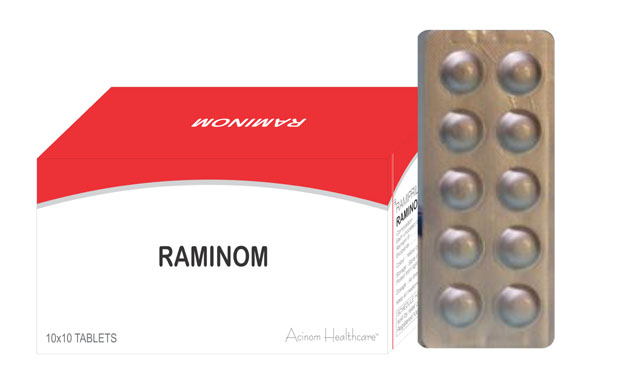Ramipril is a prodrug belonging to the angiotensin-converting enzyme inhibitor class of medications. It is metabolized to ramiprilat in the liver and, to a lesser extent, kidneys. It is a potent, competitive inhibitor of ACE, the enzyme responsible for the conversion of angiotensin I to angiotensin II . ATII regulates blood pressure and is a key component of the renin-angiotensin-aldosterone system (RAAS). Ramipril may be used in the treatment of hypertension, congestive heart failure, nephropathy, and to reduce the rate of death, myocardial infarction and stroke in individuals at high risk of cardiovascular events. Ramipril oral capsules.
Indication
For the management of mild to severe hypertension. used to reduce cardiovascular mortality following myocardial infarction in hemodynamically stable individuals who develop clinical signs of congestive heart failure within a few days following myocardial infarction. To reduce the rate of death, myocardial infarction and stroke in individuals at high risk of cardiovascular events.
● treat high blood pressure
● reduce the risk of heart attack, stroke or death in people with a high risk
● treat heart failure in people who have had a heart attack
Pharmacology
Mechanism of action:
Ramipril inhibits the RAAS system by binding to and inhibiting ACE thereby preventing the conversion of angiotensin I to angiotensin II. As plasma levels of angiotensin II fall, less activation of the G-protein coupled receptors angiotensin receptor I (AT1R) and angiotensin receptor II (AT2R) occurs.
AT1R mediates vasoconstriction, inflammation, fibrosis, and oxidative stress through a variety of signaling pathways. These include Gq coupling to the inositol triphosphate pathway, activation of phospholipases C, A2, and D which contribute to eicosanoid production, activation of Ca2+-dependent and MAP kinases, Gi and G12/13 .Decreased activation of this receptor mediates the renoprotective, antihypertensive, and cardioprotective effects of ramipril by reducing inflammation and vasoconstriction.ACE is also responsible for the breakdown of bradykinin. The resulting buildup of bradykinin due to ACE inhibition is thought to mediate the characteristic dry-cough as a side effect of ACE inhibitor medications.
Pharmacodynamics:
Ramipril is an ACE inhibitor similar to benazepril, fosinopril and quinapril. 5 It is an inactive prodrug that is converted to ramiprilat in the liver, the main site of activation, and kidneys. Ramiprilat confers blood pressure lowing effects by antagonizing the effect of the RAAS. The RAAS is a homeostatic mechanism for regulating hemodynamics, water and electrolyte balance. During sympathetic stimulation or when renal blood pressure or blood flow is reduced, renin is released from the granular cells of the juxtaglomerular apparatus in the kidneys. In the blood stream, renin cleaves circulating angiotensinogen to ATI, which is subsequently cleaved to ATII by ACE.. ADH stimulates further water reabsorption from the kidneys via insertion of aquaporin-2 channels on the apical surface of cells of the DCT and collecting tubules. Third, ATII increases blood pressure through direct arterial vasoconstriction. Stimulation of the Type 1 ATII receptor on vascular smooth muscle cells leads to a cascade of events resulting in myocyte contraction and vasoconstriction. In addition to these major effects, ATII induces the thirst response via stimulation of hypothalamic neurons. ACE inhibitors inhibit the rapid conversion of ATI to ATII and antagonize RAAS-induced increases in blood pressure. ACE is also involved in the enzymatic deactivation of bradykinin, a vasodilator. Inhibiting the deactivation of bradykinin increases bradykinin levels and may sustain the effects of ramiprilat by causing increased vasodilation and decreased blood pressure.
Pharmacokinetics:
Absorption: The extent of absorption is at least 50-60%. Food decreases the rate of absorption from the GI tract without affecting the extent of absorption. The absolute bioavailabilities of ramipril and ramiprilat were 28% and 44%, respectively, when oral administration was compared to intravenous administration. The serum concentration of ramiprilat was unchanged when capsules were opened and the contents dissolved in water.
Metabolism: Hepatic metabolism accounts for 75% of total ramipril metabolism. 25% of hepatic metabolism produces the active metabolite ramiprilat via liver esterase enzymes. 100% of renal metabolism converts ramipril to ramiprilat. Other metabolites, diketopiperazine ester, the diketopiperazine acid, and the glucuronides of ramipril and ramiprilat, are inactive.
Elimination:60% of the parent drug and its metabolites are eliminated in the urine with the remaining 40% eliminated in the feces. The drug eliminated in the feces represents both absorbed drug and drug eliminated through biliary excretion although the proportion of these has not been determined. Less than 2% of drug is eliminated in the urine unchanged.
Contraindication
Contraindications to its use include
renovascular disease , impaired blood flow in the kidneys, severe kidney impairment , volume-depleted patients, a history of angioedema while on an ACE inhibitors, pregnancy and hypotension.
Side Effects:
● dizziness or faintness due to low blood pressure.
● cough
● dizziness
● chest pain
● nausea
● vomiting
● diarrhea
● weakness or tiredness.
